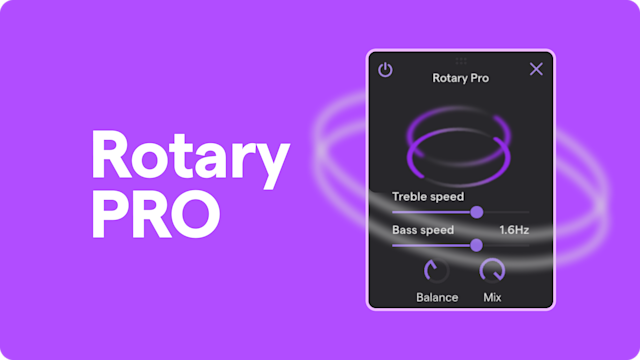From Static to Dynamic: Mastering the Rotary Effect in your Productions
September 19, 2024 - Discover and explore the Rotary Effect, transforming your mixes with movement and sonic depth.

Music is movement. Every vibration in the air tells a story, and sometimes those stories need more than just notes and chords; they need dimension, space, life. This is how the Rotary effect comes into play. This effect, which has transcended eras and genres, is one of those tools that has the power to transform a static sound into something that breathes, moves and lives.
To speak of the Rotary effect is to speak of a journey through time, from the churches and jazz halls of the mid-20th century to the digital production studios of today. It is a versatile tool that, when you know it well, becomes an extension of your sonic creativity.
A bit of history: The birth of the Rotary Effect
The Rotary effect, in its purest essence, was born with the creation of the Leslie Speaker in the 1940s. Designed by Don Leslie to complement the sound of the Hammond organ, the Leslie was not just a speaker; it was an experience. Instead of simply projecting sound, it made it spin. Yes, literally spin. With its rotating speakers, it modulated both the amplitude and phase of the sound, creating a sense of spatial motion that enveloped the listener.
This rotating speaker was composed of two parts: a rotating tweeter (horn) for the high frequencies and a woofer (drum) for the low frequencies, both moving at different speeds, which generated a tonal richness that was difficult to match. It was more than just vibration; it was as if the sound was dancing in the air.
Over time, this effect was not limited to organs. Guitars, keyboards, vocals and even synthesizers found in the Rotary a way to add that “something more” that can transform an ordinary track into something memorable.
What is the Rotary Effect today?
Today, the Rotary effect is in the form of a plugin or digital processor, faithfully replicating the behavior of the Leslie Speaker without the need for a physical device. But it is not just a simple emulation; it has evolved to be used creatively in a myriad of applications.
Simply put, the Rotary effect is a dynamic modulation that reproduces the movement of sound through rotating speakers. This movement creates fluctuations in the phase and amplitude of the sound, giving the sensation that the audio is coming from different directions. It is this three-dimensional perception that makes it such a valuable resource in music production.
Essential Rotary Effect parameters
Modern Rotary plugins offer a variety of controls depending on the creator, and these allow you to fine-tune the effect to get the result you want to achieve. Here are some of the most common parameters:
Speed: This is the heart and soul of the Rotary effect. The speed of the rotating speaker can be adjusted, but this depends on the plugin design. However, it basically consists of the speed at which the speakers rotate. It can be with a quiet rhythm or something faster and aggressive, which results in a sound with a smooth and stereo character. This is ideal for quiet passages or a more pronounced effect, creating an intense modulation which is perfect for adding energy to a section.
Acceleration: This parameter mimics how the motor of a real Leslie Speaker accelerates or decelerates. It allows the speed change to be gradual, giving that organic feeling of transitioning between slow and fast modes. Like a breeze turning into a storm, or a calm returning after the storm, this control adds drama and realism.
Mix: The balance between the processed signal and the original signal is crucial. By adjusting the mix control, you can decide how much you want the Rotary effect to affect the signal. Sometimes, a subtle touch is all you need to give depth without losing the original clarity of the sound.
Microphone distance: On real Leslie speakers, the distance between the microphone and the speakers affected how the sound was captured. Rotary plug-ins emulate this. A microphone closer to the speaker will produce a louder, punchier effect, while a more distant microphone will soften the modulation.
How to use the Rotary Effect in your productions
Production is a creative process that must move away from the rules, discover every day new possibilities experimenting with different tools in different types of sounds. These are some of the elements in which you can start using the rotary effect, but remember that it only depends on your criteria and imagination how you use it in your tracks.
On Organs:
The Rotary effect is the perfect accompaniment to any Hammond style organ. If you're working on a track that needs that vintage or jazz touch, applying a well-tuned Rotary can bring the organ to life in a way that few other effects achieve.
On Guitars:
Using the Rotary on guitars can add subtle, enveloping motion, especially on clean or arpeggiated passages. One trick is to use the fast mode at climactic moments in a song, creating a swirling sonic sensation that immerses the listener.
On Vocals:
Although less conventional, applying a Rotary effect to a vocal track can create unique effects. You can experiment with slow speeds to give a sense of spatiality or use fast modulation to create more radical, psychedelic effects.
On Pads and Keyboards:
The Rotary is ideal for adding life and movement to pads or synth lines that might otherwise sound flat. With careful adjustment of speed and mix, you can achieve atmospheres that seem to float and spin in space.
Creative Techniques for Experimenting with Rotary
Automate Speed: One of the most effective techniques is to automate in transitions the speeds between slow and fast, this helps to create interesting dynamics, especially at key moments in the song. Think about how you can take advantage of these changes to generate tension or release energy in the chorus.
Automate the Mix: You can use Mix automation to generate different feels in each section of your track. Use the effect subtly in verses and increase it during the chorus to give more energy and dynamics to your beat.
Pan + Rotary automation: Think that if using the rotary effect alone you gain a lot of spatiality, combining it with pan automation will create a much wider space, achieving a sense of immersiveness and depth in your beat.
Combine the Rotary with Reverb or Delay: To create immersive atmospheres, try placing the Rotary before a large reverb or long delay. This will make the effect feel even more immersive, filling the sound space in a unique way.
Distortion + Rotary: If you're looking for a more raw and visceral sound, applying distortion before or after the Rotary can result in really interesting textures. It works especially well with electric guitars or aggressive synths.
Subwoofer Rotary: Although the Rotary is typically used at mid-high frequencies, experimenting with the effect in sub-bass can generate unusual sounds. By applying a slow rotation to deep bass, you can create a subtle movement that adds interest without saturating the mix.
Comparison with Other Effects
Although the Rotary shares certain similarities with effects like the Chorus or Phaser, there are key differences that make it unique.
Rotary vs Chorus:
The Chorus also modulates the signal by doubling and slightly detuning the original sound. However, the Rotary adds a physical modulation in space, making it feel more three-dimensional.
Rotary vs Tremolo:
The Tremolo only modulates the amplitude of the sound, while the Rotary modulates both amplitude, phase and pan. Because of this, the Rotary offers a sense of movement that the Tremolo cannot replicate.
Rotary vs Phaser/Flanger:
Both Phaser and Flanger are phase-shift based modulation effects, but the Rotary adds the component of spatial motion, creating a more organic and less robotic effect.
Tips for Mastering the Rotary Effect
Don't overload it: Rotary can be a very powerful effect, but it's not always necessary to use it in its most extreme form. Sometimes a light touch can be just what your mix needs.
Think about space: Rotary is an effect that works in stereo space, so it's ideal for opening up your mix and giving it a sense of spaciousness. Play with the placement of the virtual speakers and the angle of the microphones to control how the effect interacts with the rest of your production.
Change it according to the context: While Rotary can sound amazing on a Hammond organ in a classic rock ballad, it can also work in modern contexts, such as EDM or trap, if used creatively.
Listen to the history of the sound: Every turn of the Rotary tells a story. It could be the whisper of an old jazz song, or the clamor of a guitar in a rock anthem. Learn to listen to that movement and let it be part of the narrative of your production.
Rotary PRO by Soundtrap
Soundtrap surprises us again with its own version of this incredible effect, with a simple but very complete interface that offers us an incredible sound.
It has parameters to adjust the speed in bass and treble frequencies independently, a Mix setting, and my favorite, allows us to adjust the balance or level between bass and treble frequencies.
Undoubtedly a great tool that you can start using in your creations using Soundtrap.

Conclusion: The perfect twist
The Rotary effect is not just a modulation tool; it's also a way to give movement and soul to your sound. Whether you're using it to bring an organ to life, add an enveloping touch to a guitar, or explore new textures on synths, pads, or other sounds, this effect can add a special dimension to your music. As a producer, learning to master it will not only allow you to expand your skills, but also take your ideas beyond the static, making them spin and dance with a life of their own.
About the author
Odiseo is a music producer and mixing and mastering engineer with experience ranging from music creation as a session and concert musician, beatmaker, live sound engineer, and recording engineer, to audio production for short films, providing a broad perspective on technical concepts and musical skills to take music to another level.
Beginnen Sie noch heute mit Soundtrap!